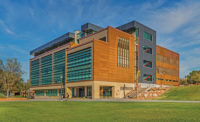Even as New York City embarks on the public review process for the planned $2-billion-plus Cornell NYC Tech Center on Roosevelt Island, some higher education professionals warn that there will likely be a funding slowdown in coming years for some parts of the sector. While the extent of the slowdown will vary depending on factors including the institution, the culprit will be the same one that has plagued all sectors during the recession—the economy, which is causing some funding sources to pull back.

That is not to say that donors in the private sector will altogether stop donating or that public sector support will altogether disappear. In fact, New Jersey is scheduled to put a $750-million bond measure on its Nov. 6 ballot that would provide matching grants to help fund construction of certain higher-ed facilities.
But the size of donations and public sector support may dip as funding sources become more cautious, said speakers at ENR New York's Making the Grade: What's Next in Higher Education Construction conference, held Oct. 9 in New York.
On the public side, "we've been able to carry a lot of weight in a down economy," Jon T. Gurney, program management director at New York’s State University Construction Fund (SUCF), told conference attendees. SUCF, which serves State University of New York schools, currently accounts for about $3 billion worth of project activity either in design or construction, Gurney says.
Going forward, however, the amount of funding for community colleges, which receive funding from the state and local government sources, is as yet uncertain. "The amounts vary and can be difficult to project because of the local funding," he says.
"We’ve seen 15 years [of growth] but the next five are going to be tough," Gurney says. Even so, he adds, SUCF plans to lobby the state for more money and expects to "put work on the street."
Speakers also discussed several of the multibillion-dollar expansion plans under way or in the planning stages at major tristate universities including Cornell and Columbia, the latter of which received a $250-million donation in 2006 to help build a new science center, one of several Columbia projects now under way. Columbia says the gift is the largest ever for a single facility at a U.S. university. Columbia is also in the first phase of a separate $6.3-billion expansion of its Manhattanville campus.
"Unlike Columbia, all of our money comes from the public sector," said Robert Lemieux, executive director of design, construction and management at the City University of New York (CUNY). The CUNY network of schools has about 300 buildings, about 290 of which are "old ones" that CUNY is more likely to reinvest in rather than replace, he says.
"We've not had anyone give us $250 million as Columbia has," Lemieux says. "Looking forward, the future looks a little bleaker" for the public side. "The future for higher education in the state is kind of tenuous at the moment," he adds.
Given that, CUNY is looking to public-private partnerships for help and announced an agreement last month with Memorial Sloan-Kettering Cancer Center (MSKCC). Under the plan, CUNY's Hunter College and MSKCC will each build facilities on a 66,000-sq-ft site at 525 East 73 rd St. in Manhattan that the city now owns but will sell to the hospital for $215 million. MSKCC plans to build a 750,000-sq-ft outpatient cancer center on the site, and Hunter plans to erect a 336,000-sq-ft science and nursing building for its faculty, researchers and students.
Private schools, meanwhile, rely more on the largess of alumni and other donors for funding construction, speakers said. But "in this economic environment, it has been difficult for private universities to secure large-scale donors," said Doug Brown, manager of BASF Corp.’s Center for Building Excellence and one of the conference moderators. Other speakers agreed, with one mentioning that the strength of a private institution’s name and reputation can weigh heavily on the size of the gift.
At Manhattan College, a small private school in Riverdale, N.Y., the main focus is on repurposing buildings rather than new construction, says Andrew Ryan, vice president of facilities. The school is, however, building a new student center that is set for completion in 2014.
Meanwhile, NYC's push to become more competitive in engineering and applied sciences is good news for the construction industry as three plans for projects under the city's Applied Sciences NYC initiative program gain speed, speakers said.
Last December, Cornell and Technion-Israel Institute of Technology were the big winners of the competition and will build the massive graduate tech school on Roosevelt Island. In April, New York University and its partner NYU-Poly were awarded $15 million under the program. This team will partner with a consortium of other universities and tech firms to build the Center for Urban Science and Progress, an engineering and science institute, in Downtown Brooklyn. In July, Columbia was awarded $15 million under the program to add a 44,000-sq-ft data sciences institute to existing buildings at its Morningside Heights and Medical Center campuses.
Overall, NYC is "coming out of a recession with what we believe is a very strong hand," says Josh Wallack, NYC Economic Development Corp. COO. But it faces significant challenges including joblessness and under-employment as well as competition from other cities that are making major investments to attract talent, he says.
In the high-tech sector, the city is competing "ferociously" and recent data show that it has made headway in attracting high-tech talent, Wallack says. In the last decade, for example, the number of patents issued to NYC-based inventors jumped by more than 50%, he says. The city also surpassed Massachusetts in 2010 as the second-largest recipient nationwide of tech-related venture capital investments. In the last five years, the city's tech-related employment has jumped by about 30% and today stands at about 120,000, he adds.
"But we cannot get comfortable," Wallack says. By some measures, New York is behind in the tech sector. About 4% of the city's private sector jobs are in science and engineering, as compared to 8% in both Boston and San Francisco, he says. The Applied Sciences NYC initiative will be an important driver in turning around such statistics, he adds, because it will greatly increase the number of graduate-level students in the sector.


Post a comment to this article
Report Abusive Comment